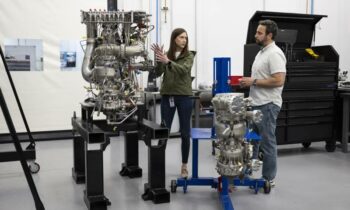By the end of the decade, a space business named Max Space plans to deliver scalable, “stadium-sized” dwellings into Earth’s orbit atop a SpaceX rocket.
The startup’s objective is simple in theory. The habitats are made to minimize the mass and volume of the payload that must be launched into space, an extremely expensive procedure, in order to maximize our living area.
Co-founder Aaron Kemmer stated in a statement, “The problem with space today is, there isn’t enough habitable space in space.” “Unless we make usable space in space a lot less expensive, and much larger, humanity’s future in space will remain limited.”
The one-year-old company’s “scalable habitat” ideas span from 20 cubic meters to an incredible 1,000, or 700 and 35,300 cubic feet, respectively. If the company’s projected launches in 2027 and 2030 come to pass, these designs will dwarf existing habitat concepts.
The company claims that these dwellings may be placed on the Moon or possibly Mars, in addition to floating in the microgravity of orbit.
“My dream is to have a city on the Moon before I die,” Kemmer stated. “So I look at this like, this is going to be the habitat, the structures, that are going to go inside the lava tubes buried under the [lunar] surface,” Kemmer stated.
All of that comes with a big disclaimer, of course: this is an extremely ambitious strategy, and the corporation will undoubtedly run into many roadblocks.
The startup’s leadership can at least benefit from some prior expertise. In order to investigate off-Earth manufacturing, Kemmer co-founded Redwire Space, formerly known as Made in Space. Redwire Space has transported multiple 3D printers to the International Space Station.
One of the main benefits of making habitats inflatable is that they may be much smaller and fit inside a rocket fairing.
At Canadian contractor Thin Red Line Aerospace, Maxim de Jong, a cofounder of Max Space, worked on the pressure-restraining hulls of two of these habitats.
In just two years, the startup plans to undertake its first off-Earth test, which will involve a module the size of two suitcases that can grow to a volume of 700 cubic feet. The company hopes to reduce costs by employing a novel and highly scalable approach.
Should things proceed as planned, the prototype might break the current record by surpassing the combined volume of the three inflatable habitats that are presently in orbit above the Earth.
However, Max Space is not the only business hoping to send a new wave of elongating habitats into space.
Sierra Space, a rival, has also been hard at work detonating full-scale inflatable habitat prototypes on Earth, with plans to begin developing flight-ready hardware by the middle of 2026.



